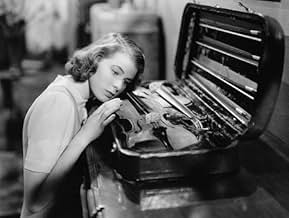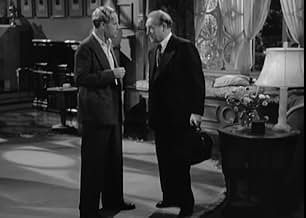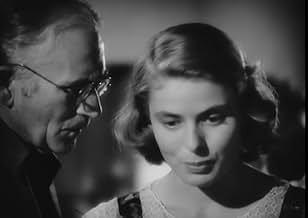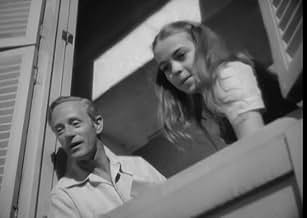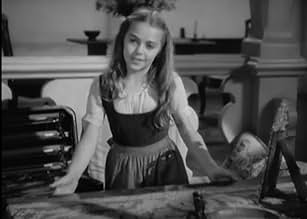Der Klavierbegleiter eines Geigers geht in den Ruhestand. Er hört den Klavierlehrer seiner Tochter.Der Klavierbegleiter eines Geigers geht in den Ruhestand. Er hört den Klavierlehrer seiner Tochter.Der Klavierbegleiter eines Geigers geht in den Ruhestand. Er hört den Klavierlehrer seiner Tochter.
- Regie
- Drehbuch
- Hauptbesetzung
- Für 1 Oscar nominiert
- 3 Gewinne & 1 Nominierung insgesamt
- Ann Marie Brandt - Their Daughter
- (as Ann Todd)
- Schoolgirl
- (Nicht genannt)
Empfohlene Bewertungen
Howard plays Holger Brandt, a married man with two children who leaves his wife and family when his affair with Bergman becomes too intense. Hoffman becomes his accompanist on tour, sublimating her own career plans because she wants to be with him. While vacationing, he becomes attached to a little girl who obviously reminds him of his daughter (Ann Todd), whom he adores, and Anita wonders if their illicit affair can ever bring them happiness.
The film is rich in subtext and metaphors. "Aren't you giving it too much importance?" Anita's piano teacher asks as she rips into a concerto. "We were all impressed with you the night you played here ... with my husband," Holger's wife says, asking Anita about her studies. "I really had no choice," Anita almost whispers. Even the title of his daughter's favorite piece that he plays, "Intermezzo" takes on a special meaning.
Few actors have cut the romantic, ethereal figure that Leslie Howard did during his film career. Tall, blond, with that soft voice and faraway look in his eyes, he makes a perfect musician who is always listening to a melody in his head. Though some people feel his phoned-in Ashley Wilkes doesn't hold up today, in fact, he was the embodiment of Ashley without making much effort, a soft dreamer with impractical values from another time. And so he is here, not thinking ahead and lost in a romantic fog.
A touching and dramatic film with very effective performances.
The film is a remake in Hollywood style of a Swedish film directed by Gustaf Molander in 1936 and equally interpreted by Ingrid Bergman ; here plays his first US role , in fact , is best known as Bergman's American debut and became her in world star . Bergman is splendid and enticing , stunningly photographed by the maestro Gregg Toland (Citizen Kane) and she obtained extraordinary reviews . Leslie Howard is agreeable and sensible as the lover who bears a guilty feeling . Fine support cast is formed by Ann Todd as the daughter who strongly loves her daddy , Cecil Kellaway in one his usual roles as likable and comical friend and John Halliday . Excellent black and white cinematography and magnificent musical score by the master Max Steiner , nominated for Academy Award and being added classic music composed by Provost , Rachmaninov and Tchaykowsky . The motion picture will appeal to romantic films buffs and vintage cinema enthusiasts . Rating : Above average . Outstanding and enjoyable.
Much of the story has to do with the guilt they both experience in terms of the familial repercussions, and the ending reflects as much. A role away from his Ashley Wilkes in "Gone With the Wind", obviously the more important Selznick movie in production a the time, Leslie Howard plays Holger in his familiar erudite manner. Veteran character actor Cecil Kellaway (later the monsignor in "Guess Who's Coming to Dinner") plays the sage maestro who acts as the film's conscience. Scenes often seem strangely truncated to move the story briskly along. Beyond Bergman, the most accomplished aspects of the film are Gregg Toland's lush cinematography, Lyle Wheeler's art direction (making Monterey, California look very much like the Italian Riviera) and Max Steiner's romantic music (oddly uncredited). But the impossibly striking Bergman is the primary reason to see this predictably developed film. The 2004 DVD offers no extras.
Off the cuff, here are seven reasons why:
1) There IS a good message here: that a married person having a fling with a pretty young woman might be an exciting prospect but in the end, "you reap what you sow" and if either of the two parties has a conscience, the illicit romance will be doomed, especially if there are kids involved.
2 ) For male viewers, Ingrid Bergman, making her English-speaking debut, is a real feast for the eyes. She was one of the more naturally gorgeous women to grace the silver screen, I think.
3) Gregg Toland's photography. To fully appreciate his work, get the DVD for this film. Toland was one of the best ever, and this is a beautifully shot piece of work.
4) At 70 minutes, the film flies by, which also makes it easier to watch and enjoy multiple times.
5) Leslie Howard and John Halliday also were excellent in here as the two male leads. I thought Halliday, in particular, had some great words of wisdom.
6) For those who appreciate how difficult it is to forgive people, this ending contained another nice message.
7) Classical music lovers will very much appreciate the soundtrack to this film.
Intermezzo is the story of a world famous concert violinist played by Leslie Howard who comes home from a world tour with his piano accompanist John Halliday to wife Edna Best and children Ann Todd and Douglas Scott. By a stroke of coincidence Ann Todd's piano teacher Ingrid Bergman is also Halliday's pupil. At a party Bergman plays and Howard picks up the violin to accompany her.
That's it for him, the beautiful music they make together kindles a romance. She goes on tour with him and it's a romantic idyll. Except of course for Best and the kids.
This version of Intermezzo is a faithful remake of the original Swedish film and the reviews that Ingrid Bergman garnered insured her American stardom. This was a busy years for Leslie Howard and David O. Selznick with both of them also involved with Gone With The Wind.
The theme from Intermezzo is most often done as an instrumental, but words were actually written for it and Tony Martin made a hit record of it at the time film was out in theater.
Seen today Intermezzo and its romantic story hold up well today. Bergman and Best are at their best fighting for the same man and Leslie Howard's charm still comes through after almost 70 years. Intermezzo got two Oscar nominations for black and white cinematography and film editing, but this was the year of Gone With The Wind.
You didn't think David O. Selznick should have taken all the Oscars home from 1939. He grabbed enough of them that year as it was.
Wusstest du schon
- WissenswertesAfter Producer David O. Selznick fired Cinematographer Harry Stradling Sr. and hired Gregg Toland to take over the photography of this, the remake of Intermezzo (1936), he asked Toland how it was possible that Ingrid Bergman looked so beautiful in the original European production and so ghastly in his Hollywood version. Toland replied, "In Sweden they don't make her wear all that makeup." Selznick immediately ordered retakes with the natural look which so dazzled the world a year later when he loaned her out to Warner Bros. for Casablanca (1942).
- Patzer(at around 32 mins) When Holger and Anita are standing outside the shop and looking at the "curious clock", their faces can be seen reflected in the shop window. As they continue their parting conversation, Anita's mouth movement suddenly mismatches what she can be heard saying. This is followed by a mixture of audible dialogue and interspersed mouth movements from both characters that produce no sound.
- Zitate
Charles Moler: [cutting into Ann Marie's birthday cake] You know what? Not so long ago your daddy and I went to a birthday party in China.
Ann Marie Brandt: In *China*?
Charles Moler: [thinking about the pronunciation] Uh-huh. At a Mandarin's house. His name was Chou Ching Chang Chip Chop.
Ann Marie Brandt: Did you have ice cream and cake?
Charles Moler: Oooh, no, indeed. We had swallows' nests, umm, roasted silkworms, snake soup and, uh... cricket eggs!
Ann Marie Brandt: Oh! You didn't eat *that*...?
Charles Moler: Oh, we had to take a double helping of everything, or the Mandarin would've murdered us.
Ann Marie Brandt: Oh, well, Uncle Charles, nobody will murder you here!
- Crazy CreditsAnd introducing Ingrid Bergman.
- Alternative VersionenA re-release uses the title "Intermezzo" and lists the copyright owner as "Vanguard Films, Inc.", which was Selznick's company name in the 1940s. Ingrid Bergman is billed first in the opening credits, which also are more elaborate than the original release. The end cast credits, however, are identical.
- VerbindungenFeatured in Hollywood: The Selznick Years (1969)
- SoundtracksIntermezzo
(1936) (uncredited)
Music by Heinz Provost
Played at the concert by Leslie Howard on violin and John Halliday on piano
Played by Howard and Ann E. Todd on piano at their home
Played by Howard and Ingrid Bergman on piano at a concert
Played on a zither by Howard
Used as background music often
Top-Auswahl
- How long is Intermezzo?Powered by Alexa
Details
Box Office
- Budget
- 800.000 $ (geschätzt)
- Laufzeit1 Stunde 10 Minuten
- Farbe
- Seitenverhältnis
- 1.33 : 1
Zu dieser Seite beitragen



